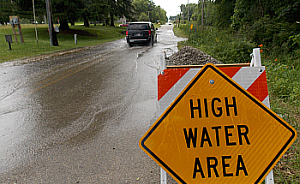 While spring brings warmer weather and longer days to Indiana, it also comes with volatile weather that can increase the risk of floods. The Indiana Department of Homeland Security (IDHS) is asking Hoosiers to take the time during Flood Safety Awareness Week, March 13-19, to plan ahead for potential flooding.
While spring brings warmer weather and longer days to Indiana, it also comes with volatile weather that can increase the risk of floods. The Indiana Department of Homeland Security (IDHS) is asking Hoosiers to take the time during Flood Safety Awareness Week, March 13-19, to plan ahead for potential flooding.
There are several steps individuals and families can take to prepare for flooding. IDHS encourages all Hoosiers develop a family emergency communications plan and put together a disaster preparedness kit. The kit should contain essential items a family needs to sustain itself for at least three days. When developing a family communications plan, make sure to include an out-of-state contact and meeting places in case the family becomes separated.
In the neighborhood
In many cases, easy preventative yard work can help minimize the effects of flooding in neighborhoods.
- High amounts of debris, especially near storm sewer drains, can impede the flow of water and contribute to potential flooding in residential areas. Using a rake or shovel can help clear storm drains while avoiding contact with flood water. Dispose of debris in compost piles or through local municipalities.
- When water levels are low, clear any debris from waterways, ditches or culverts that may obstruct water flow and force water over the banks and into neighborhoods and streets.
- Contact local emergency management officials if any large obstructions are seen in rivers or creeks. Be patient, as it may take time for the issue to be addressed. If the issue is on private property, removal may fall to the property owner.
The best time to inspect waterways and storm drains is before a rain storm, when water levels are lower and currents move more slowly. Without taking preventive measures, clogged or blocked drainage systems can lead to numerous problems.
If living near bodies of water (ponds, rivers, streams, etc.), it is important to be prepared.
- Ensure that all sump pumps are operational, and clear any gutters or drain spouts of debris.
- Have an escape plan established, including multiple routes so flooded roads can be avoided.
- Keep any important documents, such as birth certificates and Social Security cards, in a safe, waterproof file to help prevent damage.
- Monitor local weather and river forecasts and keep an eye on any waterways along roads near residences.
- Water levels can change rapidly and flooding can begin with little or no warning.
- Consider evacuating in advance of flooding if rising water may cut off access routes to and from home.
On the road
According to the National Weather Service, most flood-related deaths happen while driving. Hoosiers should also keep the following in mind when encountering flooded roadways.
- Never attempt to cross a flooded road, even if it seems shallow. Water can conceal dips, or worse, flood waters can damage roadways, washing away the entire road surface and a significant amount of ground.
- Remember, just a few inches of moving water is enough to carry away most vehicles, including SUVs and pick-up trucks.
- Be especially cautious at night when it is harder to recognize high water danger.
Flood Insurance
Floods can be very expensive, and purchasing flood insurance is one of the most cost-effective steps homeowners can take to protect their homes. FEMA’s FloodSmart website (www.floodsmart.gov) includes a tool to quickly estimate the cost of damages from various amounts of flood water in a home, as well as resources that can make a residence more flood resistant. Also conduct a home inventory of all valuables. An easy way to do this is with a home video camera or photographs. Thorough documentation of belongings can help when filing a flood insurance claim.
For more flood safety and preparedness tips, visit GetPrepared.in.gov andwww.floodsafety.noaa.gov.














